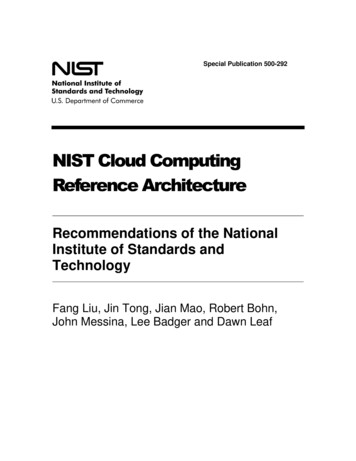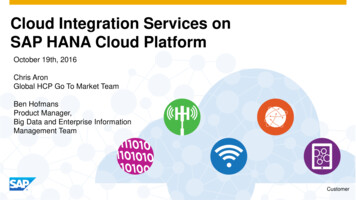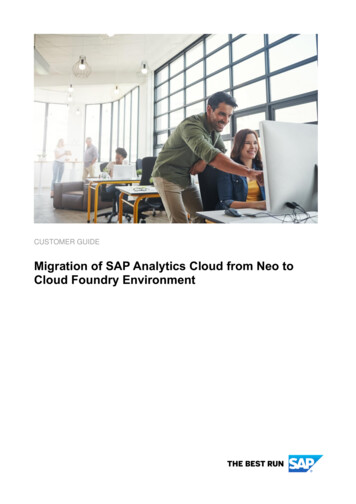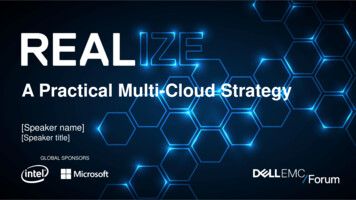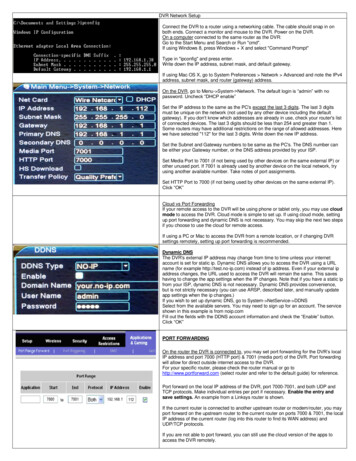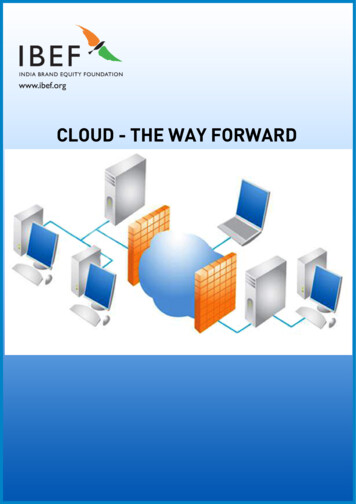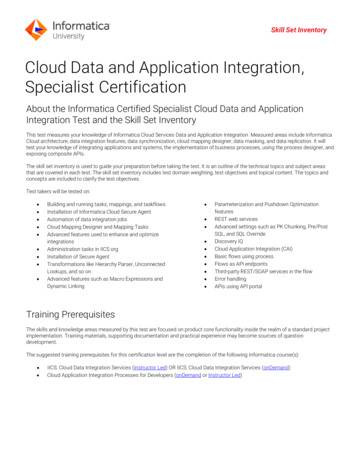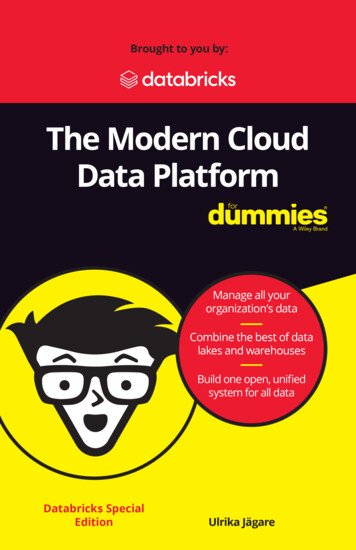
Transcription
These materials are 2020 John Wiley & Sons, Inc. Any dissemination, distribution, or unauthorized use is strictly prohibited.
The ModernCloud DataPlatformDatabricks Special Editionby Ulrika JägareThese materials are 2020 John Wiley & Sons, Inc. Any dissemination, distribution, or unauthorized use is strictly prohibited.
The Modern Cloud Data Platform For Dummies ,Databricks Special EditionPublished byJohn Wiley & Sons, Inc.111 River St.Hoboken, NJ 07030-5774www.wiley.comCopyright 2020 by John Wiley & Sons, Inc.No part of this publication may be reproduced, stored in a retrieval system or transmitted in anyform or by any means, electronic, mechanical, photocopying, recording, scanning or otherwise,except as permitted under Sections 107 or 108 of the 1976 United States Copyright Act, without theprior written permission of the Publisher. Requests to the Publisher for permission should beaddressed to the Permissions Department, John Wiley & Sons, Inc., 111 River Street, Hoboken, NJ07030, (201) 748-6011, fax (201) 748-6008, or online at http://www.wiley.com/go/permissions.Trademarks: Wiley, For Dummies, the Dummies Man logo, The Dummies Way, Dummies.com,Making Everything Easier, and related trade dress are trademarks or registered trademarks ofJohn Wiley & Sons, Inc. and/or its affiliates in the United States and other countries, and maynot be used without written permission. Databricks and the Databricks logo are registeredtrademarks of Databricks. All other trademarks are the property of their respective owners.John Wiley & Sons, Inc., is not associated with any product or vendor mentioned in this book.LIMIT OF LIABILITY/DISCLAIMER OF WARRANTY: THE PUBLISHER AND THE AUTHOR MAKE NOREPRESENTATIONS OR WARRANTIES WITH RESPECT TO THE ACCURACY OR COMPLETENESS OFTHE CONTENTS OF THIS WORK AND SPECIFICALLY DISCLAIM ALL WARRANTIES, INCLUDINGWITHOUT LIMITATION WARRANTIES OF FITNESS FOR A PARTICULAR PURPOSE. NO WARRANTYMAY BE CREATED OR EXTENDED BY SALES OR PROMOTIONAL MATERIALS. THE ADVICEAND STRATEGIES CONTAINED HEREIN MAY NOT BE SUITABLE FOR EVERY SITUATION. THISWORK IS SOLD WITH THE UNDERSTANDING THAT THE PUBLISHER IS NOT ENGAGED INRENDERING LEGAL, ACCOUNTING, OR OTHER PROFESSIONAL SERVICES. IF PROFESSIONALASSISTANCE IS REQUIRED, THE SERVICES OF A COMPETENT PROFESSIONAL PERSON SHOULD BESOUGHT. NEITHER THE PUBLISHER NOR THE AUTHOR SHALL BE LIABLE FOR DAMAGES ARISINGHEREFROM. THE FACT THAT AN ORGANIZATION OR WEBSITE IS REFERRED TO IN THIS WORKAS A CITATION AND/OR A POTENTIAL SOURCE OF FURTHER INFORMATION DOES NOT MEANTHAT THE AUTHOR OR THE PUBLISHER ENDORSES THE INFORMATION THE ORGANIZATIONOR WEBSITE MAY PROVIDE OR RECOMMENDATIONS IT MAY MAKE. FURTHER, READERSSHOULD BE AWARE THAT INTERNET WEBSITES LISTED IN THIS WORK MAY HAVE CHANGED ORDISAPPEARED BETWEEN WHEN THIS WORK WAS WRITTEN AND WHEN IT IS READ.For general information on our other products and services, or how to create a custom For Dummiesbook for your business or organization, please contact our Business Development Department inthe U.S. at 877-409-4177, contact info@dummies.biz, or visit www.wiley.com/go/custompub. Forinformation about licensing the For Dummies brand for products or services, contact BrandedRights&Licenses@Wiley.com.ISBN: 978-1-119-73023-1 (pbk); ISBN: 978-1-119-73027-9 (ebk)Manufactured in the United States of America10 9 8 7 6 5 4 3 2 1Publisher’s AcknowledgmentsSome of the people who helped bring this book to market include thefollowing:Project Editor:Carrie Burchfield-LeightonProduction Editor:Tamilmani VaradharajSr. Managing Editor: Rev MengleBusiness DevelopmentRepresentative: Karen HattanAcquisitions Editor: Steve HayesThese materials are 2020 John Wiley & Sons, Inc. Any dissemination, distribution, or unauthorized use is strictly prohibited.
Table of ContentsINTRODUCTION. 1About This Book. 1Icons Used in This Book. 2Beyond the Book. 2CHAPTER 1:Describing Current DataManagement Limitations. 3Exploring Relational Databases. 4Sorting out Data Warehouses. 4Diving into Data Lakes. 5Why a Traditional Data Lake Isn’t Enough. 6CHAPTER 2:Explaining the Concept of a Lakehouse. 7Sorting Out the Concept of a Lakehouse. 8Comparing a Lakehouse to Other DM Solutions. 9Types of data that can be used. 10Cost of DM operations and vendor lock-in. 10Ability to scale. 11Support for BI and ML. 11Solving Problems with a Lakehouse. 12CHAPTER 3:Capturing the Value of the LakehouseApproach. 13Defining Values for Building Reliable Data Lakes. 13Common data reliability problems. 14Data reliability benefits with the lakehouse approach. 15Specifying Benefits for Business Intelligence. 16Problems with a traditional BI approach. 16Enabling BI on all your data. 16Describing the Payoff for Exploratory Data Science and ML. 17Barriers toward data science productivity. 17Gains for data science collaboration. 18CHAPTER 4:Building a Modern Cloud DataPlatform with Databricks. 19Getting Started with Your Lakehouse by Using Databricks. 19Utilizing Delta Lake to Add Reliability to Your Lakehouse. 20Table of ContentsiiiThese materials are 2020 John Wiley & Sons, Inc. Any dissemination, distribution, or unauthorized use is strictly prohibited.
Adding Delta Engine to Bring Performance to YourLakehouse. 21Leveraging Databricks Unified Data Analytics Platformas Your Lakehouse. 22Sharing a Customer Case Study. 23The solution. 24The results. 25CHAPTER 5:ivTen Reasons Why You Need aLakehouse Approach. 27The Modern Cloud Data Platform For Dummies, Databricks Special EditionThese materials are 2020 John Wiley & Sons, Inc. Any dissemination, distribution, or unauthorized use is strictly prohibited.
IntroductionAs companies started to collect large amounts of data frommany different sources, data architects began envisioning asingle system to store data for many different types ofusage scenarios, including analytical products and machine learning (ML) workloads.Historically, many different solutions have been created and usedto address this need; a database, a data warehouse, and, during thelast decade, the data lake concept. These solutions have all had theirobvious benefits at the time but also different types of limitationsthat grew apparent as data management (DM) needs have changedover the years. The emergence of the cloud is creating an opportu nity for data teams to rethink their approaches. Modern cloud dataplatforms are following a new DM architecture — lakehouse.The lakehouse radically simplifies the enterprise data infrastructure and accelerates innovation in an age when ML and artificialintelligence (AI) are used to disrupt every industry. This new architecture merges the best parts from data lakes with the best partsfrom data warehouses. Therefore, more traditional data warehouse use cases are also supported with the lakehouse approach.In the past, most of the data that went into a company’s productsor decision making was structured data from operational systems,whereas today, many products incorporate AI in the form of computer vision and speech models, text mining, and others. Thatputs completely new demands on the DM system, and it’s not justabout the capabilities; it’s about the architectural approach.About This BookThe Modern Cloud Data Platform For Dummies, Databricks SpecialEdition, is about using the principles of a well-designed platformthat leverages the scalable resources of the cloud to manage allof an organization’s data. This book introduces the lakehouse inDM, and you not only discover the evolution of DM solutions, butalso you find out how the limitations of current solutions impactthe efficiency of DM. This book explains why a lakehouse is morecapable of solving the challenges of today, as well as how you canIntroduction1These materials are 2020 John Wiley & Sons, Inc. Any dissemination, distribution, or unauthorized use is strictly prohibited.
design and build a cloud data platform and what it actually meansfor your company or organization.Icons Used in This BookI occasionally use special icons to focus attention on importantitems. Here’s what you find:This icon reminds you of information that’s worth recalling.Expect to find something useful or helpful by way of suggestions,advice, or observations here, leveraging experiences from otherimplementations.Warning icons are meant to get your attention to steer you clear ofpotholes, money pits, and other hazards. Paying extra attention tothese parts in the book helps you avoid unnecessary roadblocks.This icon may be taken in one of two ways: Techies zero in on thejuicy and significant details that follow; others will happily skipahead to the next paragraph.Beyond the BookThis book helps you understand more about how the lakehousemakes your DM efforts more effective and efficient in your company. However, because this is a relatively short, introductorybook to lakehouses and cloud data platforms, I also recommendchecking out the following:»» ouse.html»» databricks.com/discover/data-lakes/history»» orm2The Modern Cloud Data Platform For Dummies, Databricks Special EditionThese materials are 2020 John Wiley & Sons, Inc. Any dissemination, distribution, or unauthorized use is strictly prohibited.
IN THIS CHAPTER»» Explaining the role of relationaldatabases»» Positioning data warehouses»» Describing the concept of data lakes»» Knowing why you need more thanthe data lakeChapter1Describing CurrentData ManagementLimitationsData management (DM) consists of methods, architecturaltechniques, and tools for gaining access to and managingdelivery of data in a consistent way across different datatypes in a company. The purpose of DM on an enterprise-widescale is to fulfill all data requirements for use cases, applications,and business processes in a company.This chapter describes how the approach to managing data haschanged over time due to various factors and how these changeshave pushed for new DM approaches to evolve. Some of theseaspects include easier access to data, increased volume of data,the emergence of unstructured data, the need for speed in datapreparation, and the necessity of reliable data pipelines thatcan constantly feed new types of use cases with data. The needfor performing analytics on all your data across multiple datasources, as well as running end-to-end ML, puts high demandson data management support. There is usually a varied set of usecases in both analytics and ML that need to be taken into account.CHAPTER 1 Describing Current Data Management Limitations3These materials are 2020 John Wiley & Sons, Inc. Any dissemination, distribution, or unauthorized use is strictly prohibited.
Exploring Relational DatabasesIn the early days of DM, the relational database was the primarymethod that companies used to collect, store, and analyze data.Relational databases offered a way for companies to store andanalyze highly structured data about their customers using Structured Query Language (SQL). For many years, relational databaseswere sufficient for companies’ needs mainly due to the fact thatthe amount of data that needed to be stored was relatively small,and relational databases were simple and reliable.However, with the rise of the Internet, companies found themselves drowning in data. To store all this new data, a single database was no longer sufficient. Companies, therefore, often builtmultiple databases organized by lines of business to hold the data.But as the volume of data just continued to grow, companies oftenended up with dozens of disconnected databases with differentusers and purposes, and many companies failed to turn their datainto actionable insights.Sorting out Data WarehousesWithout a way to centralize and efficiently use their data, companies ended up with decentralized, fragmented stores of data,called data silos, across the organization. With so much data storedin different source systems, companies needed a way to integratethem. Data warehouses were born to meet this need and to unitedisparate databases across the organization.The concept of data warehousing dates back to the late 1980s, andin essence, the data warehousing concept was intended to providean architectural model for the flow of data from operational systems to decision support environments.As data volumes grew even larger (big data), and as the needto manage unstructured and more complex data became moreimportant, data warehouses had limitations:»» Data warehouses for a huge IT project can involve highmaintenance costs.»» Data warehouses only support business intelligence (BI) andreporting use cases.4The Modern Cloud Data Platform For Dummies, Databricks Special EditionThese materials are 2020 John Wiley & Sons, Inc. Any dissemination, distribution, or unauthorized use is strictly prohibited.
»» There’s no capability for supporting ML use cases.»» Data warehouses lack scalability and flexibility whenhandling various sorts of data in a data warehouse.This started the push for yet another DM solution: data lakesthat could offer repositories for raw data in a variety offormats.Diving into Data LakesTo make big data analytics on various formats possible, and toaddress concerns about the cost and vendor lock-in of data warehouses, Apache Hadoop emerged as an open-source distributeddata processing technology. Apache Hadoop is a collection ofopen-source software for big data analytics that allowed large datasets to be processed with clusters of computers working in parallel.The introduction of Hadoop was a watershed moment for big dataanalytics for two main reasons:»» It meant that some companies could shift from expensive,proprietary data warehouse software to in-house computingclusters running on free and open-source Hadoop.»» It allowed companies to analyze massive amounts ofunstructured data (big data) in a way that wasn’t possiblebefore.Early data lakes built on Hadoop MapReduce and HDFS enjoyedvarying degrees of success. Some early data lakes succeeded,while others failed due to Hadoop’s complexity and other factors.Today, many modern data lake architectures have shifted fromon-premises Hadoop to running Apache Spark in the cloud. Still,these initial attempts were important as these Hadoop data lakeswere the precursors of the modern data lake.Shortly after the introduction of Hadoop, Spark was introduced.Spark was the first unified analytics engine that facilitated largescale data processing, SQL analytics, and ML. Spark was also 100times faster than Hadoop. When Spark was introduced, it took theidea of MapReduce a step further, providing a powerful, generalized framework for distributed computations on big data. OverCHAPTER 1 Describing Current Data Management Limitations5These materials are 2020 John Wiley & Sons, Inc. Any dissemination, distribution, or unauthorized use is strictly prohibited.
time, Spark has become increasingly popular among data practitioners, largely because it’s easy to use, performs well on benchmark tests, and provides additional functionality that increasesits utility and broadens its appeal.Today, many modern data architectures use Spark as the processing engine that enables data engineers and data scientiststo perform ETL, refine their data, and train ML models. Cheapblob storage (AWS S3 and Microsoft Azure Data Lake Storage) ishow the data is stored in the cloud, and Spark has become theprocessing engine for transforming data and making it ready forBI and ML.Why a Traditional Data Lake Isn’t EnoughWhile suitable for storing data, data lakes lack some criticalfeatures:»» They don’t support transactions.»» They don’t enforce data quality.»» Their lack of consistency and isolation makes it almostimpossible to mix appends and reads, and batch andstreaming jobs.For these reasons, many of the promises of the data lakes haven’tmaterialized, and in many cases, it has led to a loss of many of theprevious benefits of data warehouses.However, the need for a flexible, high-performance DM systemhasn’t decreased. More than ever, companies require systemsfor diverse data applications, including SQL analytics, real-timemonitoring, and ML. Most of the recent advances in AI have beenin better models to process unstructured data (text, images, video,audio). Still, these are precisely the types of data for which a datawarehouse isn’t optimized.A common approach is to use multiple systems — a data lake,several data warehouses, and other specialized systems such asstreaming, time-series, graph, and image databases to addressthe increasing needs. However, having a multitude of systemsintroduces additional complexity and, more importantly, introduces delays as data professionals consistently need to move orcopy data between different systems.6The Modern Cloud Data Platform For Dummies, Databricks Special EditionThese materials are 2020 John Wiley & Sons, Inc. Any dissemination, distribution, or unauthorized use is strictly prohibited.
IN THIS CHAPTER»» Describing the lakehouse architecture»» Comparing the lakehouse approachto data warehouses and data lakes»» Tackling challenges with the lakehouseapproachChapter2Explaining the Conceptof a LakehouseNew systems are beginning to emerge in the industry thataddress the limitations with and complexity of the twodifferent stacks for business intelligence (BI) (data warehouses) and machine learning (ML) (data lakes). A lakehouse is anew architecture that combines the best elements of data lakesand data warehouses.Lakehouses are enabled by a new system design using similar datastructures and data management (DM) features to those in a datawarehouse, directly on the kind of low-cost object storage usedfor data lakes. They’re what you would get if you had to redesigndata warehouses in the modern world, now that cheap and highlyreliable storage (in the form of object stores) are available.In this chapter, you discover all you need to know about lakehouses, including what types of problems this approach helps toovercome and why this is significantly different from other DMsolutions.CHAPTER 2 Explaining the Concept of a Lakehouse7These materials are 2020 John Wiley & Sons, Inc. Any dissemination, distribution, or unauthorized use is strictly prohibited.
Sorting Out the Concept of a LakehouseA lakehouse is a new DM architecture that enables users to doeverything from BI, SQL analytics, data science, and ML on asingle platform. To understand the concept of a lakehouse, youshould first dive deeper into the challenges of data lakes:»» Appending data is hard: Users want their changes toappear all at once. However, appending new data into thedata lake while also trying to read it causes data consistencyissues.»» Modification of existing data is difficult: You need to beable to modify and delete specific records, especially withGDPR and CCPA. Unfortunately, it takes a rewrite ofpetabytes on the data lake to make specific changes.»» Jobs failing mid-way: Job failures usually go undetectedfor weeks or months and aren’t discovered until later whenyou’re trying to access the data and find that some of it’smissing.»» Real-time operations are hard: Combining real-timeoperations and batch leads to inconsistencies because datalakes don’t support transactions.»» It’s costly to keep historical data versions: Regulatedorganizations need to keep many versions of their data forauditing and governance reasons. They manually make a lotof copies of the data, which is time intensive and costly.»» Data lakes make it difficult to handle large metadata:If you have petabytes of data in the data lake, then themetadata itself becomes gigabytes and most data catalogscan’t support those sizes.»» You have “too many files” problems: Because data lakesare file-based, you can end up with millions of tiny files or afew gigantic files. In either case, this impacts performancenegatively.»» Data lakes perform poorly: It’s hard to get great perfor-mance with big data. You have to use a number of manualtechniques like partitioning that are error-prone.»» You may have data quality issues: All the challengeseventually lead to data quality issues. It becomes harderto ensure that your data is correct and clean.8The Modern Cloud Data Platform For Dummies, Databricks Special EditionThese materials are 2020 John Wiley & Sons, Inc. Any dissemination, distribution, or unauthorized use is strictly prohibited.
The lakehouse takes an opinionated approach to building datalakes by adding data warehousing attributes — reliability, performance, and quality, while retaining the openness and scale ofdata lakes. It supports»» ACID transactions: Every operation is transactional. Thismeans that every operation either fully succeeds or aborts.When aborted, it’s logged, and any residue is cleaned so youcan retry later. Modification of existing data is possiblebecause transactions allow you to do fine-grained updates.Real-time operations are consistent, and the historical dataversions are automatically stored. The lakehouse alsoprovides snapshots of data to allow developers to easilyaccess and revert to earlier versions for audits, rollbacks, orexperiment reproductions.»» Handling large metadata: Lakehouse architecture treatsmetadata just like data, leveraging Apache Spark’s distributed processing power to handle all its metadata. As a result,it can handle petabyte-scale tables with billions of partitionsand files with ease.»» Indexing: Along with data partitioning, lakehouse architec-ture includes various statistical techniques like bloom filtersand data skipping to avoid reading big portions of the dataaltogether, and therefore deliver massive speed ups.»» Schema validation: All your data that goes into a table mustadhere strictly to a defined schema. If data doesn’t satisfythe schema, it’s moved into a quarantine where you canexamine it later and resolve the issues.Comparing a Lakehouse toOther DM SolutionsIn the past, decision making was based mainly on structured datafrom operational systems. It’s essential for a DM system of todayto be much more flexible and also support unstructured data inbasically any format, enabling advanced ML techniques.CHAPTER 2 Explaining the Concept of a Lakehouse9These materials are 2020 John Wiley & Sons, Inc. Any dissemination, distribution, or unauthorized use is strictly prohibited.
With the lakehouse approach, this flexibility is achieved throughdeeply simplifying the data infrastructure to enable acceleratinginnovation. This is especially important at a time when ML is revolutionizing all industries and demands an elastic infrastructuresupporting speed and operational efficiency.Figure 2-1 gives a high-level overview of three differentapproaches to DM. The first two — data warehousing and datalakes — have been leading the industry during different timeperiods. The lakehouse approach is a brand-new architecture for2020 and comes with some obvious architectural differences. Thissection sorts out the differences in more detail.FIGURE 2-1: The differences between a data warehouse, a data lake,and a lakehouse.Types of data that can be usedOne significant difference between these approaches regards whatdata it’s intended for. Although a data warehouse only handlesstructured data, both a data lake and a lakehouse handle structured data, semi-structured data, and unstructured (raw) data. Inthe current data landscape in most companies, that’s not only agood capability to have, but also it’s an essential one.Cost of DM operationsand vendor lock-inVendor lock-in refers to how applications or system solutions,which store data in proprietary formats, can make it hard forother systems to use the data. It can cause a customer to becomedependent on a particular vendor for products and services andmake the customer unable to use another vendor solution withoutsubstantial costs for switching solutions. This problem can lead10The Modern Cloud Data Platform For Dummies, Databricks Special EditionThese materials are 2020 John Wiley & Sons, Inc. Any dissemination, distribution, or unauthorized use is strictly prohibited.
to companies being forced to create multiple data copies to makedata accessible to other third-party systems. This approach isn’tgood for making your data architecture future-proof.In the DM space, the data warehouse approach comes with significant operational cost and vendor lock-in, which makes the datawarehouse solution inflexible and less cost efficient than both thedata lake and the lakehouse approach because both approachescome with low operational cost and no vendor lock-in. In a lakehouse, data is stored in open data formats, which is a good foundation for making the data architecture future-proof.Ability to scaleScalability in DM solutions refers to the capability of the systemto handle a growing amount of data as well as increased workload.Scalability is essential in that it contributes to competitiveness,efficiency, reputation, and quality. These factors are especiallyimportant to consider for small businesses because they have thebiggest growth potential.When analyzing the data warehouse approach, you soon realizethat it comes with clustered or coupled storage, and the computeresources don’t scale. Clustered or coupled storage refers to theuse of two or more storage servers working together to increaseperformance, capacity, or reliability.Clustering distributes workloads to each server, manages thetransfer of workloads between servers and provides access toall files from any server regardless of the physical location of thefile. This should be compared to the data lake and the lakehouse,which are both highly scalable and use low-cost scalable storageand on-demand elastic compute.Support for BI and MLWhile the main capabilities of a data warehouse may once haveaddressed the data related challenges at hand by offering supportfor SQL queries, BI reporting, and dashboarding, the DM challenges of today are quite different. The data warehouse approachisn’t future-proof because it’s missing support for predictions,real-time (streaming) data, flexible scalability, and managingraw data in any format.CHAPTER 2 Explaining the Concept of a Lakehouse11These materials are 2020 John Wiley & Sons, Inc. Any dissemination, distribution, or unauthorized use is strictly prohibited.
The data lake approach, on the other hand, may, at a first glance,look almost the same as the lakehouse approach with its supportfor low operational cost, flexibility, scalability, and allowing storage of the raw data in any format needed for ML. But it has severaldrawbacks (I cover these in Chapter 1).But the key benefit with the lakehouse is that it allows you tounify all your data and run all of your analytics and ML in a singleplace.Solving Problems with a LakehouseA lakehouse enables business analytics and ML at a massive scale.The challenges that can be overcome with a lakehouse approachare several:»» Unifying data teams: One of the biggest benefits of alakehouse is that it unifies all your data teams — dataengineers, data scientists, and analysts — on onearchitecture.»» Breaking data silos: A lakehouse approach facilitatesbreaking data silos by providing a complete and firm copy ofall your data in a centralized location. This enables everyonein your organization to access and manage both structuredand unstructured data.»» Preventing data from becoming stale: In a continuousmanner, the lakehouse approach can process batch andstreaming data, updating tables and dashboards in near realtime so your data is always generating value, stayingupdated, and never becoming stale.»» Reducing the risk of vendor lock-in: The lakehouse approachuses open formats and open standards that allow your data tobe stored independent of the tools you currently use to processit, making it easy at any time to move your data to a differentvendor or technology.12The Modern Cloud Data Platform For Dummies, Databricks Special EditionThese materials are 2020 John Wiley & Sons, Inc. Any dissemination, distri
OR WEBSITE MAY PROVIDE OR RECOMMENDATIONS IT MAY MAKE. FURTHER, READERS SHOULD BE AWARE THAT INTERNET WEBSITES LISTED IN THIS WORK MAY HAVE CHANGED OR DISAPPEARED BETWEEN WHEN THIS WORK WAS WRITTEN AND WHEN IT IS READ. For general in



